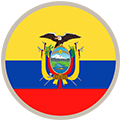This tax guide provides an overview of the indirect tax system and rules to be aware of for doing business in Ecuador.
| Indirect tax snapshot | |
|---|---|
|
What are the current rate(s) of VAT?
|
|
|
Are there any confirmed or anticipated changes to these rates?
|
Yes.
The general VAT rate was modified from 12% to 13% in the regulation, with the possibility that the president, after a favourable opinion from the finance authority, may increase it up to 15%.
|
|
What is the principal indirect tax?
|
The Value Added Tax (VAT) is the main indirect tax in Ecuador. This tax is levied on the value of the transfer of ownership or the importation of movable property of a corporeal nature, in all its stages of commercialization, as well as copyright, industrial property and related rights; and the value of the services provided.
|
|
Is there a registration limit for the tax?
|
No.
|
|
Does the same registration limit apply to non-established businesses?
|
Does not apply.
|
|
Does a non-established person need to appoint a fiscal representative in order to register?
|
Yes. A non-established person must have a representative or attorney in Ecuador to register.
|
|
How often do returns have to be submitted?
|
Most businesses are required to submit VAT on a monthly basis.
However, taxpayers classified as entrepreneurs (who have income less than or equal to USD 300k), can submit their VAT returns on a semi-annual basis.
|
|
Are penalties imposed for the late submission of returns/payment of tax?
|
Yes. In case of late filing of the VAT return, or the corresponding payment, the taxpayer must pay the respective penalty and interest.
|
|
Are any other declarations required?
|
No.
|
|
Are penalties imposed in other circumstances?
|
Yes. Penalties can be imposed for omissions notified by the Tax Administration.
|
|
Can the tax incurred by overseas businesses be claimed if they are not registered in your country?
|
Does not apply.
|
|
Deduction of VAT
|
In general terms, the VAT is not deductible but creditable; therefore, the VAT is deductible only when the taxpayer is not entitled to credit the VAT.
|
Please click on each section to expand further:
Contact us
For further information on indirect tax in Ecuador please contact:
Ruth Ortiz
T +593 958998260
E ruth.ortiz@tax.ec.gt.com

